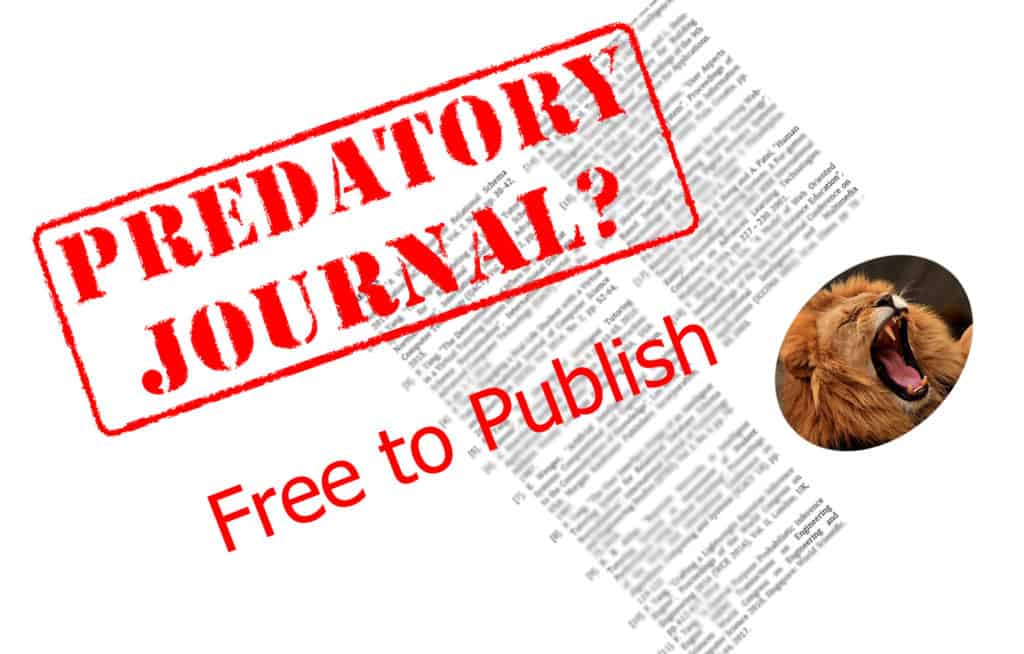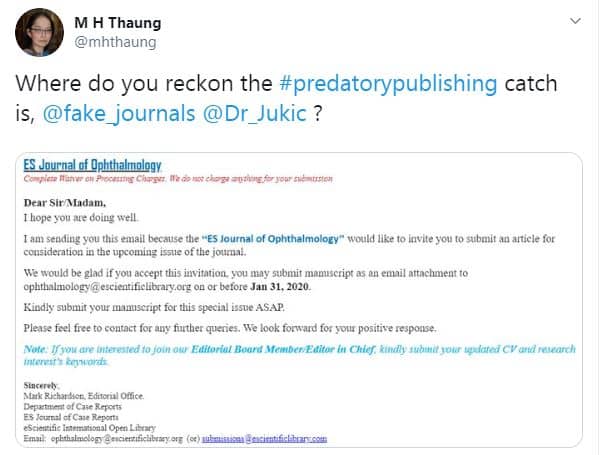Disclosure: This page may contain affiliate links. This means, at no additional cost to you, we receive a commission if you click through and make a purchase.
Motivation for this article
Is it a predatory journal?
- Before we look at the reasons why a predatory journal, might waive its article processing charges, we ought to decide if we think the journal mentioned in the tweet is a predatory journal.
Drawing on our article “Three quick ways to spot a predatory journal”, we make the following comments/observations:
- The journal promises very fast review times: On the web site, it actually says that reviewing will take 4-6 weeks. This is actually reasonable. It is quick for many established journals, but it does give the impression that they are serious about getting reviews, although seeing the quality of the reviews would be helpful.
- The journal promises very fast publication times: The journal does not give any information about this, other than to say “the publication process would be chosen relying on the quality of the paper.” We know that this is not particularly helpful. We do note that the journal has yet to publish any papers, so there is nothing we can look at to validate the publication time.
- Validate the editorial board: We took a couple of people listed as being members of the editorial board. This is what we found:
- We looked up Mandeep Tomar, Department of ophthalmology, Dr. Yashwant Singh Parmar Government Medical Colleg, India (yes, the ‘e’ is missing off college). We chose this person as they were at the top of the list.
- If you go to the staff page (accessed 06 Feb 2020) of Dr. Yashwant Singh Parmar Government Medical College, no person with this name exists. The screen shot shows just the Department of Ophthalmology. Only two people are listed, with neither being “Mandeep Tomar”.
- We next looked at S Karkuzhali, Department of Computer Science and Engineering, Anna University, India. We chose this person as their department seemed a little strange (i.e. Computer Science and Engineering).
- If you go to their staff pages (accessed 06 Feb 2020) there is no mention of S Karkuzhali on any of their pages.

It is important that we point out that we are not questioning these two researchers. It is the journal that appears to be at fault in not providing full details, or links, to members of their editorial board. Indeed, the two researchers listed above might be unaware that they are listed on the web site.
We also took the opportunity to look at some other aspects of the journal. It does not fill us with confidence. For example:

- The Articles in Press, Current Issue, Archive and Special Issue links all lead to pages which say “Will be updated soon …” This suggests that the journal has not published anything yet, which supports our view that they are willing to waive their fees to get a few papers to publish, which they can then leverage off.
- There are grammatical errors on the web site, as well as links which do not lead anywhere. For example:
- On the home page, the links to “Cover Letter“, “Join as an Editor” and “Join as a Reviewer” all lead nowhere. The link is https://www.escientificlibrary.com/ophthalmology/index.php#, which just links to the same page, i.e. the home page of the journal.
- On the home page it says “We accept the process and publish the research in its most appropriate manner ‘Peer-reviewed’ by our highly-qualified editorial team members” (we are unsure what is meant by ‘We accept the process”)
- On the home page it says “Compaining the scholarly articles for Citations” (we are not sure what is meant by ‘compaining’)
- On the home page it says “eScientific International Open Library articles are free accessible across the globe“. It should be ‘freely’
That may not sound like too many issues but this is just on a home page which is quite small. If we can find so many issues on a small home page, what does that say about the quality of the journal?
Journal starting up
If a journal is new it may seem value in attracting articles, rather than fees; at least in the first instance. A journal can hardly refer to its success if it has only published a few articles, or even zero. However, if they get a few articles, or even issues, published it suddenly has a track record that it can leverage on to attract more, fee paying, articles.
If a suspected predatory publisher is offering to waive its fees, you might want to look at the archive to see how established the journal is.
In the case of this ES Journal of Ophthalmology, they have yet to publish any articles, so this could be their way of populating their first issue and then go after fee paying papers?
Appear to be a traditional journal
Traditional journals do not charge an open access fee, as they ask you to sign over the copyright and they make their money by subscriptions to the journal or direct sales of an individual article. Of course, many traditional publishers now offer an open access route, but at least there is still an opportunity to publish papers for “free” if you are unable/unwilling to pay the open access fee.
By not having any article processing charges, at least in the short term, might make you think that the journal is from a traditional publisher. You might then be more inclined to publish in that journal again, even if it now charges an APC.
Get credible names on papers
Another reason why certain authors might be targeted for a fee waiver, is so that the journal gets well known authors to publish in their journals. This will be seen, by some, as a reason to publish in the journal on the basis that if somebody they know has published in the journal, the journal must be credible.
Others may not been given a fee waiver but might argue (to themselves) that the article processing charge is unfortunate but as somebody they know has published in the journal, and they respect that person, it is a good journal to publish in, depite the cost.
Impersonating another journal
Although not specially about waiving fees, some journals may be trying to cause confusion as to which journal you are submitting to. If they are able to create confusion, it could attract a submission, which meets their aim of populating the journal with initial content.
As an example, we searched for “Journal of Ophthalmology” and the serach returned the following in the top set of hits:
- American Journal of Ophthalmology
- American Academy of Ophthalmology
- Asia-Pacific Journal of Ophthalmology
- BMJ Open Ophthalmology
- British Journal of Ophthalmology
- European Journal of Ophthalmology
- International Journal of Ophthalmology
- Journal of Ophthalmology
- Open Journal of Ophthalmology
- Ophthalmology
- Malaysian Journal of Ophthalmology
We note that the journal that we have mentioned in this article, that is the “ES Journal of Ophthalmology“, does not appear in (at least) the top ten hits.
We should add that we have not looked at these journals in detail, nor is the list complete, so we are not in a position to make any comment about whether they are predatory journals or not. However, we are sure that there will be a mixture.
In future articles, we plan to look at sets of journals, for different disciplines and compare them by various criteria.
Attract authors from different countries
Many predatory journals tend to attract papers from a certain region in the world, or even a single country. Inviting authors to publish for free would be a way of trying to broaden the authorship so that it makes the journal look more international.
Enhance their editorial board
Inviting somebody to publish in their journal, fee free, might just be a way of starting a conversation which will lead to an invite to sit on their editorial board. If they can get a recognized name as a member of their editorail baord, it is probably of even more benefit than that name being an author.
However, there are many examples of where predatory journals just list members as part of the editorial board, without actually asking them.
Ask you to edit a special issue
Predatory journals may ask you to edit a special issue of a journal, and give you a fee waiver. The benefits to the journal are obvious. They get somebody to do all the work, even better if the guest editor is well known, and they get a number of papers for which they will receive fees.
It is interesting to note that the guest editor is unlikely to be paid for their efforts, but that is a discussion for another day.
Loss leader for the future
This item really sums up everything we have been saying above. Offering to publish a paper(s) for free could be a loss leader for the future. It populates the journal, it gets recognized names to publish in the journal, it broadens the authorship etc. Like supermarkets, they offer a product which loses them money, in the hope they will get a return on that investment somewhere down the line.
Conclusion
In this article we have suggested several reasons why predatory journals may offer you a fee waiver. These range from getting initial content, building a live email list and trying to give the journal credibility by attracting well known authors.
As we show above, by a very quick Google search, there is no lack of journals for a given area (in the case of our search; Ophthalmology) so there is little excuse to send an article to a predatory journal.
Just so that our advice is clear, you should NOT publish in a predatory journal. It really is a bad strategy, as we discuss in one of our other articles.



